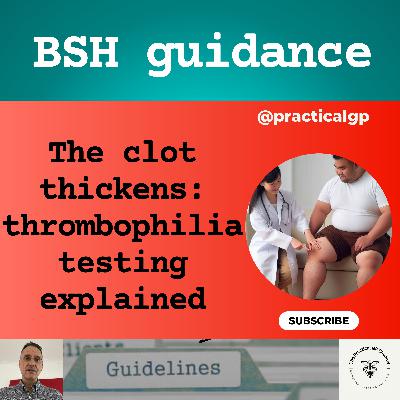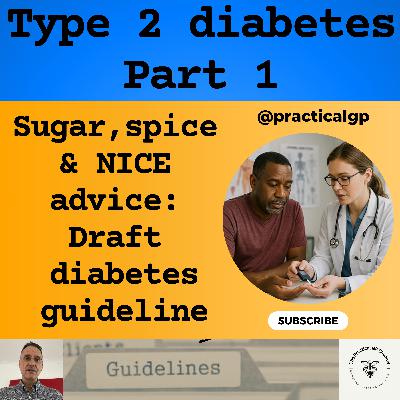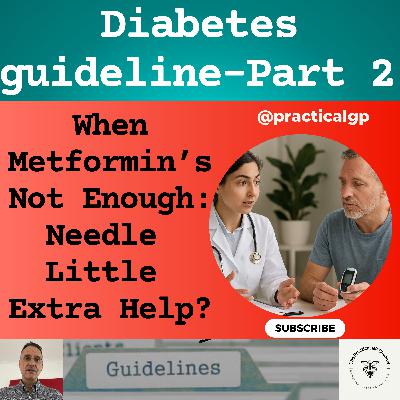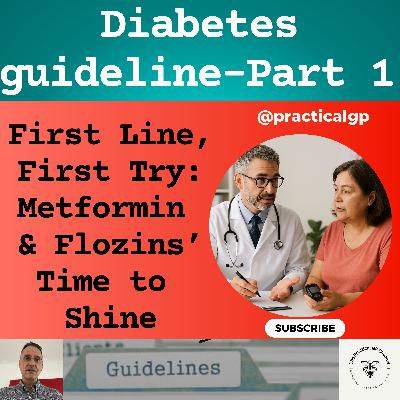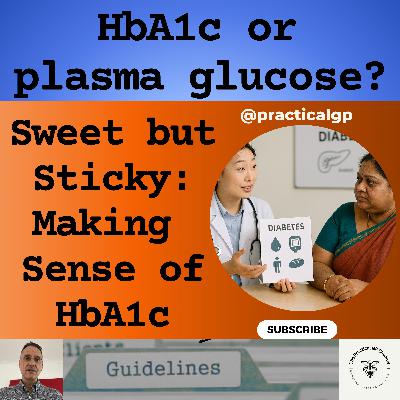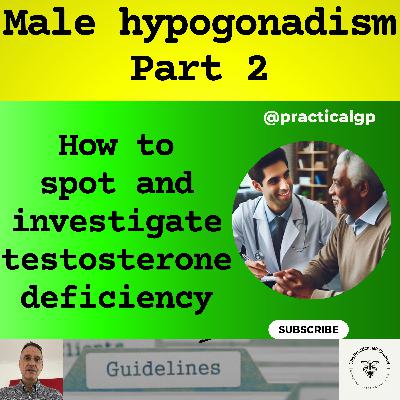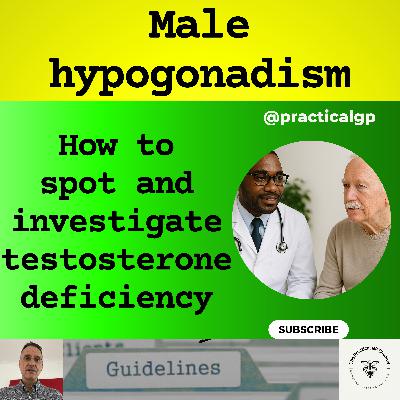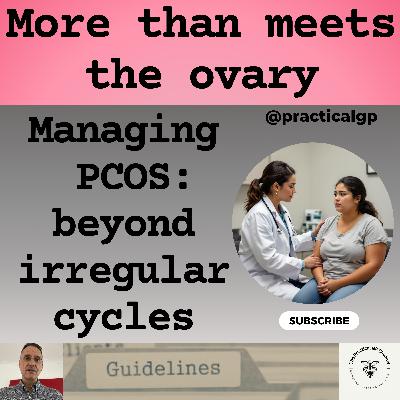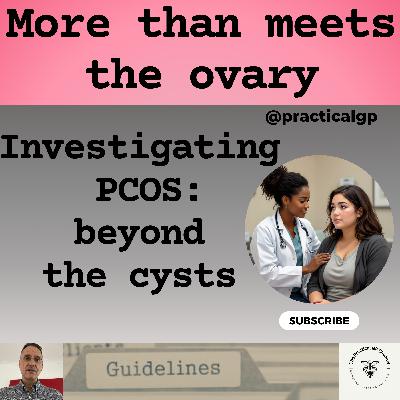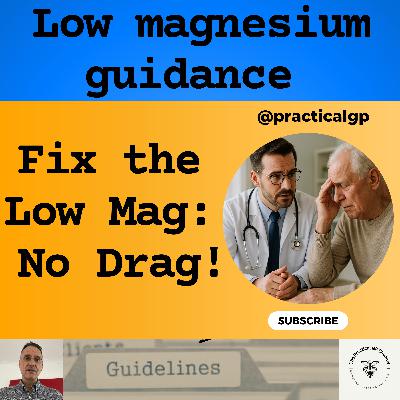Podcast - The clot thickens: Thrombophilia testing explained
Description
The video version of this podcast can be found here:
· https://youtu.be/mq658X-teEc
This channel may make reference to guidelines produced by the British Society for Haematology. The content on this channel reflects my professional interpretation/summary of the guidance and I am in no way affiliated with, employed by or funded/sponsored by them.
My name is Fernando Florido (also known as Juan Fernando Florido Santana), a GP in the UK. In this episode, I will go through the guideline by the British Society for Haematology on thrombophilia testing, focusing on what is relevant in Primary Care only.
I am not giving medical advice; this video is intended for health care professionals, it is only my summary and my interpretation of the guidelines and you must use your clinical judgement.
Intro / outro music: Track: Halfway Through — Broke In Summer [Audio Library Release]
- Music provided by Audio Library Plus
- Watch: https://youtu.be/aBGk6aJM3IU
- Free Download / Stream: https://alplus.io/halfway-through
There is a podcast version of this and other videos that you can access here:
Primary Care guidelines podcast:
· Redcircle: https://redcircle.com/shows/primary-care-guidelines
· Spotify: https://open.spotify.com/show/5BmqS0Ol16oQ7Kr1WYzupK
· Apple podcasts: https://podcasts.apple.com/gb/podcast/primary-care-guidelines/id1608821148
There is a YouTube version of this and other videos that you can access here:
- The Practical GP YouTube Channel:
https://youtube.com/@practicalgp?si=ecJGF5QCuMLQ6hrk
The link to the guideline by the British Society for Haematology on thrombophilia testing can be found here:
· https://onlinelibrary.wiley.com/doi/10.1111/bjh.18239
The link for the British Society for Haematology website can be found here
Disclaimer:
The Video Content on this channel is for educational purposes and not intended to be a substitute for professional medical advice, diagnosis, or treatment. Always seek the advice of your physician or other qualified health provider with any questions you may have regarding a medical condition. Never disregard professional medical advice or delay in seeking it because of something you have read or seen on this YouTube channel. The statements made throughout this video are not to be used or relied on to diagnose, treat, cure or prevent health conditions.
In addition, transmission of this Content is not intended to create, and receipt by you does not constitute, a physician-patient relationship with Dr Fernando Florido, his employees, agents, independent contractors, or anyone acting on behalf of Dr Fernando Florido.
Transcript
If you are listening to this podcast on YouTube, for a better experience, switch to the video version. The link is in the top right corner of the video and in the episode description.
Hello and welcome, I am Fernando, a GP in the UK. Today, we will go through the guideline by the British Society for Haematology on thrombophilia testing, focusing on what is relevant in Primary Care only. A link to it is in the episode description. We’ll go through the main tests included in a thrombophilia screen, explain why they matter, and go over when screening is recommended in specific clinical situations.
Right, let’s jump into it.
Thrombophilia is a condition where the blood has an increased tendency to clot. This increases the risk thrombosis and may be inherited, acquired, or a mix of both.
However, thrombophilia screening focuses only on factors identifiable through laboratory testing. Broader contributors like cancer, inflammation, and obesity, although linked to thrombosis, cannot be assessed with this panel and we are not going to address them today.
A thrombophilia screen includes a number of tests which we are going to group by their pathophysiological mechanism:
First, we assess for deficiency of natural anticoagulants like Antithrombin, Protein C and Protein S. Deficiencies in any of these increase the clotting risk. A simple way to remember them is with the mnemonic: C, S, A — Coagulation Suppressors Absent.
Second, we look for genetic mutations that make clotting factors resistant to natural anticoagulants. These include, Factor V Leiden and Prothrombin Gene Mutation. These mutations lead to excess clotting either by preventing anticoagulation or by increasing clotting factor levels.
Third, we consider acquired autoantibodies that interfere with the body's anticoagulant mechanisms or activate endothelial cells. These include Lupus anticoagulant, Anti-cardiolipin antibodies and Anti-β2-glycoprotein I antibodies. These markers are typically associated with antiphospholipid syndrome.
I hope that grouping the thrombophilia screen this way will make it easier to understand and remember.
We can classify thrombophilias between hereditary and acquired thrombophilias. The most clearly defined genetic thrombophilias are the factor V Leiden variant, the prothrombin gene mutation, protein C deficiency, protein S deficiency, and antithrombin deficiency.
On the other hand, important acquired thrombophilias include antiphospholipid syndrome, paroxysmal nocturnal haemoglobinuria, myeloproliferative neoplasms and the presence of a JAK2 mutation. Pregnancy is a hypercoagulable state due partly to physiological changes.
Both heritable and acquired thrombophilias can interact to further increase the risk of thrombosis, for example during pregnancy and the postpartum period.
So now, let’s consider the actual laboratory testing. And the first issue to look at is, should we screen the general population for thrombophilia?
And although Elevated levels of procoagulant factors may increase the risk of thrombosis, the relationship is not straightforward. Why is this?
- Firstly, there is a Multifactorial Risk. Thrombosis isn’t caused by one factor alone. Other conditions like obesity, inflammation, or immobility may coexist with elevated procoagulant factors, confounding the interpretation.
- Then there is the Dual Roles of Coagulation Proteins. That is, some factors have both procoagulant and anticoagulant roles, which makes the overall effect more difficult to assess.
- And then there is the issue of Limited Predictive Value. Measuring elevated levels of these factors (like Factor VIII, fibrinogen, etc.) may show associations with thrombosis risk in population studies, but it doesn’t consistently predict individual risk.
So, in summary, the guideline does not recommend routine screening of procoagulant factors because it would not change the management for the majority of people. Instead, it supports individualised decision-making.
Now, let’s look and the significance of testing in each category of test.
The first category refers to natural anticoagulants. What about testing for their Deficiency?
The associations of Protein C, Protein S and Antithrombin deficiencies with increased risks of VTE are well-established. The degree of deficiency is variable but in general thrombosis risk rises as soon the levels of protein C, S or Antithrombin fall below the normal range.
These deficiencies also interact with acquired risks. It has been found that a transient provoking factor is present in approximately 50% of episodes of thrombosis in genetically predisposed people.
Another consideration is that, when testing for deficiencies of physiological anticoagulants, this should be performed only after 3 months of anticoagulation for acute thrombosis, given that the result would not change the initial acute management and there is uncertainty over the validity of earlier results.
The next category of tests includes Factor V Leiden and prothrombin gene mutation.
These two cases are the most common genetic variants predisposing to thrombosis. Their prevalence varies in populations of different ethnicity, being more common in people of European descent and being rare or absent in other ethnicities.
There are a large number of other genetic variants but the only ones that are included in thrombophilia panels at present are these two, factor V Leiden and prothrombin gene mutation because the clinical relevance of other genetic types is not well established.
The last two categories of tests make reference to cases acquired thrombophilia. They can be genetic and non-genetic.
Let’s look at the non- genetic causes first and the main one

